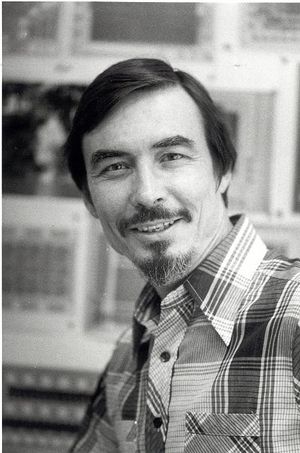Carver A. Mead
- Birthdate
- 1934/05/01
- Birthplace
- Bakersfield, CA, USA
- Associated organizations
- California Institute of Technology
- Fields of study
- Microelectronics
- Awards
- IEEE John von Neumann Medal
Biography
Carver A. Mead was born on May 1, 1934 in Bakersfield, CA. He received the B.S., M.S., and Ph.D. degrees from the California Institute of Technology in 1956, 1957, and 1960 respectively.
Dr. Mead has spent his entire career at the California Institute of Technology, where he was Gordon and Betty Moore Professor of Engineering and Applied Science. He is broadly known for his vision of microelectronics as the enabling technology oft he information revolution. He has brought that vision into reality in the form of numerous innovations, inventions, and scientific findings. He is widely recognized as the sole inventor of the Schottky-barrier gate field-effect transistor, later called the MESFET, and now, made with modern materials, known as the HEMT. These devices are the basis for virtually all, microwave receivers used in satellite communications, cellular telephones, global positioning systems, radar systems and so on. They are also the active elements in all GaAs integrated circuits and high-speed optical fiber interfaces.
Dr. Mead pioneered the application of computer automation in the design of very-large-scale integrated (VLSI) circuits. With his student David Johannsen, he developed the first silicon compilers, and used them to demonstrate a new design style. The result, substructured custom design, is applied today, in one form or another, by most semiconductor companies. His work in design automation led to a new business model in the microelectronics industry: fabrication is provided by silicon foundries, allowing companies specializing in application areas to undertake design. His approach enabled a new wave of information technology, led by U.S. companies, a story that forms the central theme in George Gilder's book entitled Microcosm.
The availability of millions of transistors, integrated on a single silicon chip, led Dr. Mead to develop neuromorphic electronic systems, whose functions and principles of operation closely model those of living nervous systems. In these systems, all functions operate in real time on continuous, real-world inputs, and are integrated seamlessly on the silicon surface. Products based on these principles are now appearing in the marketplace. They have the potential to transform completely the interface between computers and the analog world of images, sounds, and people.
Dr. Mead is a Fellow of the IEEE, the American Physical Society, and the American Academy of Arts and Sciences. He is a Member of the National Academy of Engineering, the National Academy of Sciences, and a Foreign Member of the Royal Swedish Academy of Engineering Sciences. He has received the T.D. Callinan Award, Electronics Achievement Award, Harold Pender Award,John Price Wetherhill Medal, Harry Goode Memorial Award, a Centennial Medal of the IEEE, Secretary of the Navy Captain Robert Dexter Conrad Award, and Honorary Doctorates from the University of Lund, Sweden, and the University of Southern California. In 2022, he won the Kyoto Prize for Advanced Technology.
Carver Mead resides both in Pasadena and Los Gatos, California. His outside interests include hiking, reading, traveling, and fine art.
